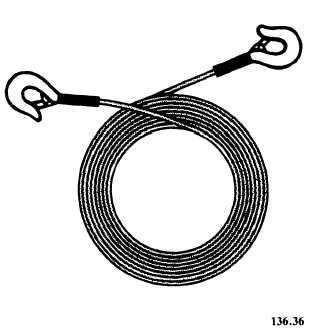depends upon the conditions under which it is used. The person wearing the suit should return immediately to a safe, cool area if he or she experiences severe discomfort such as difficulty in breathing or extreme heat. Heavy clothing should be worn under the suit to give additional protection from heat.
If the asbestos suit becomes wet, as is more than likely in firefighting, the wearer might be scalded unless withdrawal from the heated area is accomplished before the water turns to steam. Continued wetting will keep the wearer cool, but the suit will become water soaked and reduce freedom of movement, already restricted by the cumbersome suit.

Figure 4-76.—Steel wire life-line.
Life-lines
The life-line is a steel-wire cable, 50 feet long. Each end is equipped with a strong hook that closes with a snap catch. The line is very pliable and will slide freely around obstructions. See figure 4-76.
Life-lines are used as a precautionary measure to aid in the rescue of persons wearing rescue breathing apparatus, hose masks, or similar equipment. Rescue, if necessary, should be accomplished by having another person equipped with a breathing apparatus follow the life-line to the person being rescued, rather than by attempting to drag the person out. Attempts to drag a person from a space may result in fouling the life-line on some obstruction or in parting the harness, in which case it would still be necessary to send a rescue person into the space.
An important point to remember is that a stricken person must never be hauled by a life-line attached to the waist. The victim may be dragged along the deck a short distance, but his or her weight must never be suspended on a line attached to the waist. If not wearing a harness of some kind, pass the line around the chest under the armpits and fasten it in front or in back.
When tending a life-line, you must wear gloves to be able to handle the line properly. Play out the line carefully, so that it will not foul. Try to keep the life-line in contact with grounded metal; do not allow it to come in contact with any energized electrical equipment.
Detection Devices
The detection devices used to test the atmosphere in closed or poorly ventilated spaces include the OXYGEN INDICATOR, for detecting oxygen deficiency; COMBUSTIBLE-GAS INDICATORS, for determining the concentration of explosive vapors; and TOXIC-GAS INDICATORS, such as the CARBON MONOXIDE INDICATOR for finding the concentration of certain poisonous gases. The devices are extremely valuable and should be used whenever necessary; however, they MUST BE USED ONLY AS DIRECTED. Improper operation of these devices may lead to false assurances of safety or, worse yet, to an increase in the actual danger of the situation. For example, the use of a flame safety lamp in a compartment filled with acetylene or hydrogen could cause a violent explosion.
RESCUE PROCEDURES
If you are faced with the problem of rescuing a person threatened by fire, explosive or poisonous gases, or some other emergency, do not take any action until you have had time to determine the extent of the danger and your ability to cope with it. In a large number of accidents the rescuer rushes in and becomes the second victim. Do not take unnecessary chances! Do not attempt any rescue that needlessly endangers your own life!
Phases of Rescue Operations
In disasters where there are multiple patients (as in explosions or ship collisions), rescue
